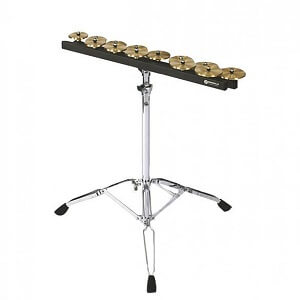Crotale
 The crotales (also referred to as ‘antique cymbals’) is an idiophone of European origin comprised of a set of metal disc-shaped plaques. Its sounding objects are graduated in size and arranged in keyboard fashion. It is an auxiliary percussion instrument used sparingly in the orchestra and somewhat more regularly in works for percussion ensembles.
The crotales (also referred to as ‘antique cymbals’) is an idiophone of European origin comprised of a set of metal disc-shaped plaques. Its sounding objects are graduated in size and arranged in keyboard fashion. It is an auxiliary percussion instrument used sparingly in the orchestra and somewhat more regularly in works for percussion ensembles.
This crotales set consists of 26 bronze, disc-shaped plaques, 13 mounted on each of two metal bars. Each plaque might be described as a thick disc with a central and integral cylindrical stump (about .5 inch in both diameter and height) protruding from one of its faces. Each crotale roughly approximates the shape of sn antique cymbal, but the latter have a hollow dome at their center that makes it a vessel of sorts. Each crotale instead has only a hole drilled through its solid stump-like center for mounting, no cavity to speak of. The cymbal-bells are graduated in size, ranging from 5 inches (lowest-pitched) to 3 inches (highest pitched) in diameter. Each support bar has 13 piers that terminate in an upward-pointing metal rod with a threaded end. The hole in a cymbal-bell is slipped over a rod, stump-side first, with small rubber washers separating it from its pier and a wing nut that is screwed onto the end of the rod to hold the unit stationary. The support beams are designed to arrange the crotales in the fashion of a keyboard with ‘white-key’ notes in a single un-gapped row and ‘black-key’ notes elevated slightly in a second row and clustered in groups of two and three discs. Each horizontal support bar is screwed to the top of a metal stand. Acoustically only the thick rim of each crotale is active when struck.